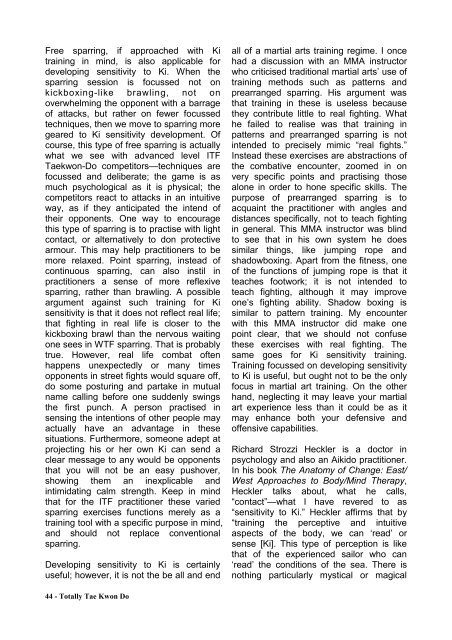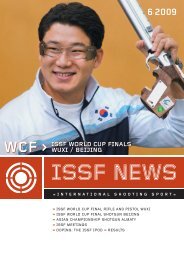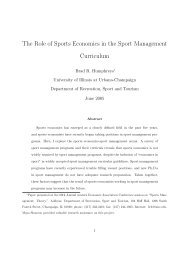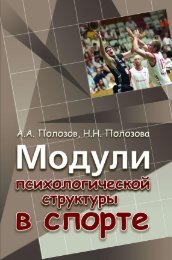Totally Tae Kwon Do Magazine - Issue 17 - Usadojo
Totally Tae Kwon Do Magazine - Issue 17 - Usadojo
Totally Tae Kwon Do Magazine - Issue 17 - Usadojo
You also want an ePaper? Increase the reach of your titles
YUMPU automatically turns print PDFs into web optimized ePapers that Google loves.
Free sparring, if approached with Ki<br />
training in mind, is also applicable for<br />
developing sensitivity to Ki. When the<br />
sparring session is focussed not on<br />
kickboxing-like brawling, not on<br />
overwhelming the opponent with a barrage<br />
of attacks, but rather on fewer focussed<br />
techniques, then we move to sparring more<br />
geared to Ki sensitivity development. Of<br />
course, this type of free sparring is actually<br />
what we see with advanced level ITF<br />
<strong>Tae</strong>kwon-<strong>Do</strong> competitors—techniques are<br />
focussed and deliberate; the game is as<br />
much psychological as it is physical; the<br />
competitors react to attacks in an intuitive<br />
way, as if they anticipated the intend of<br />
their opponents. One way to encourage<br />
this type of sparring is to practise with light<br />
contact, or alternatively to don protective<br />
armour. This may help practitioners to be<br />
more relaxed. Point sparring, instead of<br />
continuous sparring, can also instil in<br />
practitioners a sense of more reflexive<br />
sparring, rather than brawling. A possible<br />
argument against such training for Ki<br />
sensitivity is that it does not reflect real life;<br />
that fighting in real life is closer to the<br />
kickboxing brawl than the nervous waiting<br />
one sees in WTF sparring. That is probably<br />
true. However, real life combat often<br />
happens unexpectedly or many times<br />
opponents in street fights would square off,<br />
do some posturing and partake in mutual<br />
name calling before one suddenly swings<br />
the first punch. A person practised in<br />
sensing the intentions of other people may<br />
actually have an advantage in these<br />
situations. Furthermore, someone adept at<br />
projecting his or her own Ki can send a<br />
clear message to any would be opponents<br />
that you will not be an easy pushover,<br />
showing them an inexplicable and<br />
intimidating calm strength. Keep in mind<br />
that for the ITF practitioner these varied<br />
sparring exercises functions merely as a<br />
training tool with a specific purpose in mind,<br />
and should not replace conventional<br />
sparring.<br />
Developing sensitivity to Ki is certainly<br />
useful; however, it is not the be all and end<br />
44 - <strong>Totally</strong> <strong>Tae</strong> <strong>Kwon</strong> <strong>Do</strong><br />
all of a martial arts training regime. I once<br />
had a discussion with an MMA instructor<br />
who criticised traditional martial arts’ use of<br />
training methods such as patterns and<br />
prearranged sparring. His argument was<br />
that training in these is useless because<br />
they contribute little to real fighting. What<br />
he failed to realise was that training in<br />
patterns and prearranged sparring is not<br />
intended to precisely mimic “real fights.”<br />
Instead these exercises are abstractions of<br />
the combative encounter, zoomed in on<br />
very specific points and practising those<br />
alone in order to hone specific skills. The<br />
purpose of prearranged sparring is to<br />
acquaint the practitioner with angles and<br />
distances specifically, not to teach fighting<br />
in general. This MMA instructor was blind<br />
to see that in his own system he does<br />
similar things, like jumping rope and<br />
shadowboxing. Apart from the fitness, one<br />
of the functions of jumping rope is that it<br />
teaches footwork; it is not intended to<br />
teach fighting, although it may improve<br />
one’s fighting ability. Shadow boxing is<br />
similar to pattern training. My encounter<br />
with this MMA instructor did make one<br />
point clear, that we should not confuse<br />
these exercises with real fighting. The<br />
same goes for Ki sensitivity training.<br />
Training focussed on developing sensitivity<br />
to Ki is useful, but ought not to be the only<br />
focus in martial art training. On the other<br />
hand, neglecting it may leave your martial<br />
art experience less than it could be as it<br />
may enhance both your defensive and<br />
offensive capabilities.<br />
Richard Strozzi Heckler is a doctor in<br />
psychology and also an Aikido practitioner.<br />
In his book The Anatomy of Change: East/<br />
West Approaches to Body/Mind Therapy,<br />
Heckler talks about, what he calls,<br />
“contact”—what I have revered to as<br />
“sensitivity to Ki.” Heckler affirms that by<br />
“training the perceptive and intuitive<br />
aspects of the body, we can ‘read’ or<br />
sense [Ki]. This type of perception is like<br />
that of the experienced sailor who can<br />
‘read’ the conditions of the sea. There is<br />
nothing particularly mystical or magical

















